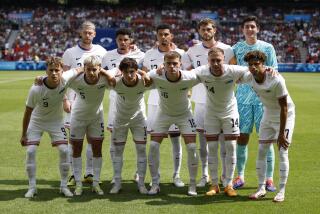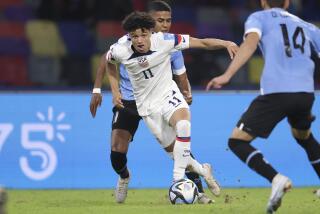In Davis’ View, Things Are Looking Up
So our boys in faded denim stars and adidas stripes are up against it, right? Backs pressed to the Rose Bowl’s outer barbed-wire security fence. Facing mighty, and mighty agitated, Colombia today, with Gheorghe Hagi the Great and the Romanian empire on deck Sunday.
Easier for the Americans to find a needle in Carlos Valderrama’s haircut than to win either one of those games and advance to the World Cup’s second round, no?
Clearly, these are times that try men’s soles.
Rick Davis, however, remembers worse. Davis remembers when he would have given his NASL North American Player of the Year trophy, his United States captain’s armband and the FIFA All-Star game jersey off his back for the opportunity to be pummeled by the Colombians in a World Cup match, any World Cup match.
With the possible exception of Kyle Rote Jr., Davis ranks as the biggest name in the history of U.S. soccer. And Rote achieved his fame primarily for his uncanny ability to scale walls during the Superstars competitions of the 1970s. Davis was the NASL’s first U.S.-born star, a starting midfielder for the two-time league champion New York Cosmos, and captain of the U.S. national team throughout the 1980s.
He was our Franz Beckenbauer, our Johan Cruyff, though very few outside the narrow cult of U.S. soccer realized it.
This is because, in a soccer sense, Davis was also our Ernie Banks. The right man at the wrong time. The elite talent stranded on a wretched team.
Banks never played in a World Series and Davis never made it to a World Cup. It wasn’t their fault. The Chicago Cubs of the 1950s and ‘60s were the U.S. soccer nationals of the 1980s. And vice versa. Banks and Davis deserved better, but where else could they go? Banks was chained to the Cubs because he played in the pre-free agent era. Davis was stuck, too, but even more so. He was born American.
Suppose Joe Montana had been born in Bulgaria, or Joe Namath in Norway. Hard to reach the Super Bowl from there. Davis was born in Denver and raised in Claremont--both a long ways from Manchester, England--and from there, he attempted to qualify for the World Cup in 1978, 1982 and 1986.
“We never came close,” Davis says.
“We were in over our heads.”
For one, he says, “the U.S. team then was nowhere near as good as the team today. And, our preparation was horrendous. We had no training center. We were a vagabond team. We’d just hop on a plane and play in a qualifying game. Then we’d come home, wait a few weeks and do it all over again.”
For example: “If we had a qualifying game in Trinidad, typically we would fly into Miami, train at the University of South Florida for a few days, then hop on a plane, play the game, then go back to our individual homes. In a few weeks, we’d have another game in Canada, so we’d fly up to train in Seattle, then go up to Canada for the game.”
The traveling circus produced clownish results. Canada crushed the Americans in the 1978 playoffs, 3-0. In 1982, the U.S. team finished dead last in its group. In 1986, the Americans proved they could handle the Netherlands Antilles--you may recall the ticker-tape parade--but couldn’t beat Costa Rica in their own back yard, losing the final qualifier, 1-0, in Torrance.
The red, white and blue might have had a better chance, Davis muses, if they had played that one inside the Forum.
“After the NASL died in the mid-80s,” Davis says, “virtually all the best soccer players in the U.S. were playing indoors. If we had 20 players on the roster, 16 of them would be playing indoors.
“Meanwhile, Canada and Costa Rica would be playing outdoors 10 months out of the year. We were at a huge disadvantage.”
Partly due to Davis’ urging, the U.S. Soccer Federation finally got its act together under one roof, establishing a national training center before the 1988 Olympics. By then, knee problems were beginning to drag Davis’ playing career to a halt, but at the same time, World Cup ’90 loomed on the horizon.
Davis viewed it as “my last shot.”
Those ailing knees hobbled smack-dab into Bob Gansler, the newly appointed U.S. coach, who, according to Davis, “wanted to leave a strong impression immediately. He came in with guns a-blazing.”
Gansler told his team that all reputations and resumes would be checked at the door and the 20 roster spots would be determined solely on what Gansler observed from here on out.
No special allowance would be made for Rick Davis, NASL and MISL hero, who was on doctor’s orders to rest a minor knee cartilage tear for a couple of weeks.
So Davis participated in opening drills with the other hopefuls and the knee began to swell. Every few days, Davis would have it drained, so he could continue training camp.
After two months of this, Davis had aggravated the knee so badly that his doctor ordered him off the field for five to six weeks, right in the middle of qualifying competition.
Finally, after 40 years, the United States qualified for the World Cup tournament, but Davis did not.
“I watched that World Cup from a TV commentating booth,” Davis says with a certain wistfulness. “It was just not meant to be.”
Now 35 and coach-general manager for the Salsa, Davis is back in the booth for Cup ‘94, providing commentary for ABC and ESPN. He is not an impartial observer; Davis is pulling for American advancement to the next round, and sees it all hinging on Sunday’s match against Romania.
“Colombia is not a good matchup for us, and it’s now in a must-win situation,” he says. “What the U.S. needs is for Romania to beat Switzerland (today). If that happens and Romania is assured of advancement, they might kick back in that third game Sunday.”
Whatever transpires, Davis will watch, and probably wince just a bit. Davis calls his failure to play in a World Cup “probably the first- or second-biggest disappointment I had as a professional soccer player.
“My perspective has always been that the World Cup is it, going back to 1966 and my first exposure to the World Cup. My father bought a couple tickets to the closed-circuit broadcast of the final between England and West Germany at the Forum and I was blown away. To me, that was the ultimate.
“From that day forward, I planned a course that would take me to the World Cup. From making the U.S. junior team to playing in the pros to making the Olympic team--all my dreams and aspirations were geared for me to be there one day.”
Enjoy it while you can, Davis would tell the young Americans. From a lack of experience, he can attest: Three games in the World Cup beat no games in the World Cup. By a country kilometer.






